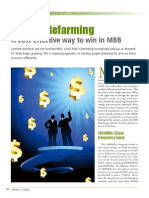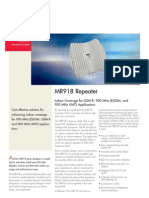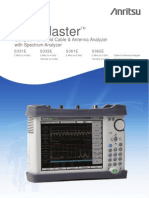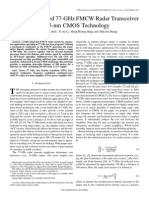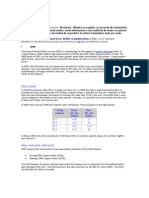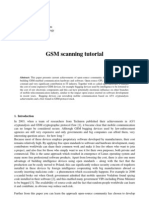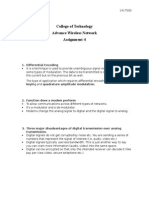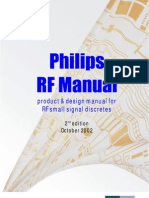Rohde & Schwarz - Signal Generator - SME06
Rohde & Schwarz - Signal Generator - SME06
Uploaded by
mnolasco2009Copyright:
Available Formats
Rohde & Schwarz - Signal Generator - SME06
Rohde & Schwarz - Signal Generator - SME06
Uploaded by
mnolasco2009Original Title
Copyright
Available Formats
Share this document
Did you find this document useful?
Is this content inappropriate?
Copyright:
Available Formats
Rohde & Schwarz - Signal Generator - SME06
Rohde & Schwarz - Signal Generator - SME06
Uploaded by
mnolasco2009Copyright:
Available Formats
Articles
Signal Generator SME06/SMT06 high-power attenuator (eg 10 or 20 dB)
can be switched in. This external atten-
uation can be taken into account in
SME and SMT as an offset, and the
Analog and digital signals for signal generator then indicates the level
after the attenuator. In this way mea-
receiver measurements up to 6 GHz surement errors are prevented.
The boom in the communications sector is continuing. More and more mobile-
Synthesizer concept
radio networks and new radiocommunication applications are being devised.
As the frequency bands below 3 GHz are already densely occupied, increasing The market success of the Rohde &
use will have to be made of the region above 3 GHz. Rohde & Schwarz has Schwarz signal generators proves that
responded to this trend by extending its line of signal generators by two new the right concepts were chosen. This
models: SME06 and SMT06 for the frequency range up to 6 GHz. holds both for SMT, which is a budget-
FIG 1
Externally identical
models SME06
and SMT06 extend
signal-generator
family to cover
analog and digital
receiver measure-
ments up to 6 GHz.
Photo 42 455
Since 1993, Rohde & Schwarz Signal With SME06 and SMT06, the mea- priced solution with a single-loop
Generators SME and SMT for up to surement technology for these applica- synthesizer, and for SME, which fea-
3 GHz have been highly successful on tions is in place well ahead of time. tures direct digital multiloop frequency
the market. Now this signal-generator synthesis, short settling times and
family has grown by two new members: The two new models are based on their digital modulation. From the different
models SME06 (FIG 1) and SMT06 lower-frequency “brothers” and were synthesizer concepts, different fields of
for applications up into the 6-GHz developed using frequency doubling. application are obtained.
range. Good news for customers who In other words, SME06 and SMT06 are
have to meet requirements which identical to SME03 and SMT03 up to SMT covers the complete range of
stipulate immunity to interference tests 3 GHz except for overvoltage protec- conventional analog receiver and EMC
on electrical equipment up to 4 GHz. tion, which is not provided on the new measurements, while SME is capable
SMT06 is an ideal and at the same models since it would result in a consid- of both analog and digital modulation.
time cost-effective signal source for erable deterioration of the output reflec- Moreover, thanks to its fast frequency
this purpose. Further applications will tion coefficient at 6 GHz. Despite this, synthesis, SME is ideal for measure-
open up in the 5-GHz range, where reflected RF power up to 1 W is per- ments on frequency-hopping systems
intensive R&D is under way on new missible with SME06 and SMT06. To and for tasks where every millisecond
systems such as WLAN (wireless local eliminate any danger when working counts, eg tests on integrated circuits,
area network), WLL (wireless local on transceivers, which often have RF since test time for the IC manufacturer is
loop) and electronic road toll systems. output powers above 1 W, an external equivalent to test costs. A reduction of
10 News from Rohde & Schwarz Number 151 (1996/II )
Articles
test time from 20 to a few milliseconds, standard, an LF generator can be PRBS sequences can be selected as
for example, will substantially reduce fitted to SME/SMT to supply sinewave, fixed standard patterns of various
manufacturing costs. With 500 µs triangular, squarewave and noise lengths or user-programmed with the
settling time in the list mode, SME offers signals. The maximum frequency for aid of a list editor. Moreover, exter-
an excellent prerequisite for cutting sinewaves is 500 kHz. A multifunction nally generated data sequences up to
down on these costs. generator provides the same signals a length of 8 Mbits can be stored in
as the LF generator over an extended SME. Such sequences are needed, for
The difference between the two synthe- frequency range up to 1 MHz and, example, for propagation measure-
sizer concepts can clearly be seen, for in addition, stereo multiplex and ments in GSM networks. In SME, spu-
example, from the SSB phase noise VOR/ILS modulation signals. The mul- rious AM and FM can be added to
(FIG 2), where SME features excellent tifunction generator makes SME/SMT the digital modulation. This allows
values close to the carrier up to 10 kHz. suitable even for highly demanding receivers to be tested not only with
With –115 dBc at 1 kHz from a 1- GHz measurements on FM stereo and virtually ideal signals but also with
carrier, SME can compete with the very VOR /ILS navigation receivers. A pulse interference signals as encountered in
best of today’s low-noise generators. generator supplies single and double practice [2].
Its favourable SSB phase-noise values pulses up to 10 MHz. It can be inter-
make SME ideal for substituting a local nally or externally triggered. The pulse
Ease of operation
oscillator, especially when it comes to delay can be selected between 40 ns
critical applications in digital trans- and 1 s. The signals generated by Despite the wealth of functions provided,
mission and radar systems. SMT, on the SME/SMT are available at separate operation of SME is extremely easy
other hand, shows its strength at more outputs for external applications so that thanks to a well thought-out operating
than 100 kHz from the carrier. With in some cases there is no need for an concept featuring a large LCD display
SSB phase noise of –150 dBc at 1 MHz external AF or pulse generator. and menu guidance. All parameters
from a 1- GHz carrier, SMT is suitable and conditions selectable for a specific
for blocking measurements even on Besides the analog modulation modes function are logically arranged in a
high-end receivers. named above, SME06 provides virtually single display. The user can be sure of
all types of digital modulation used in not overlooking any hidden criteria or
today’s mobile-radio networks: GMSK, options associated with a particular
Modulation
GFSK, FSK, FFSK, 4FSK, QPSK, function.
SME and SMT feature versatile mod- O-QPSK and π /4-DQPSK, the data of
ulation modes for tests on communi- the QPSK-based modulation modes Another feature that greatly facilitates
cations, navigation, telemetry and degrading in the range above 3 GHz. operation is the patented, magnetically
broadcast receivers. The generators The bit rate, filters and frequency de- locking tuning knob. Although smooth-
are capable of simultaneous AM, FM viation can be selected over a wide running, it provides fine stepping which
(ϕM) and pulse modulation. For two- range, and a variety of combinations the user can clearly distinguish. As a
tone modulation, internal and external is possible. With 4FSK and QPSK, the result, the display of SME/SMT need
sources can be combined. The AM bit rate can be set in the ranges 1 to not be watched all the time, eg in step-
frequency range is DC to 100 kHz, 24.3 kbit/s and 27 to 48.6 kbit/s [1]. wise tuning. Tiresome turning from one
the FM range DC to 8 MHz (SMT) or
2 MHz (SME) with maximum deviation
of 40 MHz (SMT) and 4 MHz (SME).
A special control circuit ensures high
carrier-frequency accuracy in the FM
DC mode. DC coupling is possible also
with phase modulation. The ϕM band-
width is 2 MHz for SMT and 100 kHz
for SME. Another valuable feature is
the high-quality pulse modulation, fea-
turing a rise/fall time shorter than 10 ns
and an on/off ratio better than 80 dB.
The versatile modulation capabilities
FIG 2
are backed up by a variety of modu-
SSB phase noise
lation sources. In addition to a fixed- of SME and SMT
frequency generator incorporated as at 1 GHz
News from Rohde & Schwarz Number 151 (1996/II ) 11
Articles
Future-proof investment
It is difficult to say at present what new
applications lie ahead in radiocom-
munications. There are however two
reasons pointing to a strong increase in
the demand for test equipment for the
3-to-6-GHz range: first, the range up to
2.7 GHz is already densely occupied
FIG 3 so that higher frequencies will have
Level frequency to be used to an increasing extent.
response of SMT06 Second, the trend towards higher fre-
at 0 dBm output level
quencies is being speeded up through
new technologies allowing the use of
small, favourably priced components.
With its Signal Generators SME06 and
SMT06, Rohde & Schwarz takes ac-
display to another, eg when operating the step time in a list, the automatic test count of this trend already now, making
SME/SMT and another instrument at run can be started. sure that the right instrumentation is
the same time, is a thing of the past. ready and in place.
Remote control of SME/SMT is normal- Johann Klier
Operator convenience is further en- ly via the IEC/IEEE-bus interface. If no
hanced by a variety of useful features. IEC/IEEE-bus interface is available on
Every RF specialist is aware of the prob- the external PC, the RS-232-C interface
lem: the higher the operating frequency can be used instead. This is expedient, REFERENCES
in a test system, the more difficult it is to for example, if a long data sequence [1] Klier, J.: Extensions to Signal Generator
apply the RF signal to the EUT without has to be reprogrammed in SME and SME for testing new digital networks. News
from Rohde & Schwarz (1994) No. 146,
any losses or appreciable frequency SME should remain in the test system. In
pp 40 – 41
response occurring on the connecting such cases SME can be reprogrammed
[2] Klier, J.: Simulating vector errors with
lines. Here the user correction function on site via the RS-232-C interface with Signal Generator SME. News from Rohde &
is helpful: level correction values for up the aid of a laptop. Schwarz (1995) No. 148, pp 32 – 33
to 160 frequency points can be stored
in SME/SMT, the values between these
points being determined automatically
by interpolation (FIG 3). This allows the
Condensed data of Signal Generator SME06/SMT06
frequency response of external cables
Frequency range 5 kHz to 6 GHz
to be corrected and the level at the EUT
Setting time SME06/SMT06 <10 ms (< 500 µs in list mode) / <15 ms
to be kept constant. The user correction
Spurious (f < 1.5/3/6 GHz) < –80/– 74/–68 dBc
function is equally valuable in EMC SSB phase noise
measurements, where the frequency (f = 1 GHz, at 20 kHz from carrier)
response of amplifiers, antennas or SME06/SMT06 < –126 dBc/< –116 dBc
TEM cells connected after the signal Level range –144 to +13 dBm (overrange 16 dBm)
generator are to be compensated. This AM/FM/ϕM SME06 DC to 100 kHz/2 MHz/100 kHz
AM/FM/ϕM SMT06 DC to 100 kHz/8 MHz/2 MHz
does away with complicated, external
Digital modulation (SME only) GMSK, GFSK, FSK, FFSK, 4FSK, QPSK,
level controls or test routines.
O-QPSK and π /4-DQPSK
Pulse modulation
For frequently repeated measurement On/off ratio > 80 dB
series or sequences of different types Rise/fall time <10 ns
of single measurements, the memory Pulse generator single pulse, double pulse, external trigger
Pulse repetition period 100 ns to 85 s
sequence function affords convenience Pulse width 20 ns to 1 s
otherwise obtained only through pro- Pulse delay 40 ns to 1 s
cessor control. Up to 50 instrument set- Multifunction generator sinewave, triangular, squarewave, noise,
tings can be stored in nonvolatile mem- VOR/ILS modulation signals, stereo MPX signals
ory. After programming the sequence Reader service card 151/03
of measurements (up to 256 steps) and
12 News from Rohde & Schwarz Number 151 (1996/II )
You might also like
- Proptotyping 5G Radio Using Adalm Pluto SDR With MATLAB CodeDocument8 pagesProptotyping 5G Radio Using Adalm Pluto SDR With MATLAB CodeSulaim King XNo ratings yet
- ECE Exam Primer PDFDocument129 pagesECE Exam Primer PDFEmil Eugene DomingoNo ratings yet
- Automated Broad and Narrow Band Impedance Matching for RF and Microwave CircuitsFrom EverandAutomated Broad and Narrow Band Impedance Matching for RF and Microwave CircuitsNo ratings yet
- Engineering Physics: Cell Phone ReceptionDocument10 pagesEngineering Physics: Cell Phone ReceptionBhavanya RavichandrenNo ratings yet
- Advanced Mobile Phone SystemDocument7 pagesAdvanced Mobile Phone Systemrameshbe048030No ratings yet
- 2G Huawei RefarmingDocument25 pages2G Huawei RefarmingVito Wahyudi75% (4)
- Indoor Radio Planning: A Practical Guide for 2G, 3G and 4GFrom EverandIndoor Radio Planning: A Practical Guide for 2G, 3G and 4GRating: 5 out of 5 stars5/5 (1)
- LimeMicro Whitepaper2 PDFDocument7 pagesLimeMicro Whitepaper2 PDFThevesteNo ratings yet
- Data SheetDocument40 pagesData SheetMohamed YuosefNo ratings yet
- nanoBTS 1800-1900Document2 pagesnanoBTS 1800-1900merrion123No ratings yet
- Rohde Schwarz SMB100A DatasheetDocument45 pagesRohde Schwarz SMB100A DatasheetMohammed AliNo ratings yet
- Huaptec Company Profile 2016Document46 pagesHuaptec Company Profile 2016Hassan DaudNo ratings yet
- Final Study MaterialDocument49 pagesFinal Study MaterialnileshNo ratings yet
- Project Report of IdeaDocument62 pagesProject Report of IdeaUtsav SharmaNo ratings yet
- SFDR3Document7 pagesSFDR3Flamank FlamankNo ratings yet
- Multi-Standard Receiver DesignDocument54 pagesMulti-Standard Receiver DesignWalid_Sassi_TunNo ratings yet
- Hw-094161load Balancing TrafficDocument3 pagesHw-094161load Balancing TrafficCoco Val EyzaNo ratings yet
- MR 918Document4 pagesMR 918nebolukiNo ratings yet
- Site Master: Ompact Handheld Cable & Antenna AnalyzerDocument16 pagesSite Master: Ompact Handheld Cable & Antenna AnalyzerTahseen MosafarNo ratings yet
- Mitigating Interference To Maximize Spectral Effi Ciency in 3G/4G NetworksDocument5 pagesMitigating Interference To Maximize Spectral Effi Ciency in 3G/4G NetworksVikram FernandezNo ratings yet
- Hoja de Datos - 2538Document19 pagesHoja de Datos - 2538Luis AsmatNo ratings yet
- Schaffer 2009Document11 pagesSchaffer 2009Zhenyu YangNo ratings yet
- Measuring EDGE SignalsDocument3 pagesMeasuring EDGE SignalsKien TranNo ratings yet
- JSSC 10 Jri Lee FMCW 77ghzDocument11 pagesJSSC 10 Jri Lee FMCW 77ghzwearoleNo ratings yet
- A Checklist For Designing RF Sampling ReceiversDocument7 pagesA Checklist For Designing RF Sampling ReceiversPete AirNo ratings yet
- Antennas For MIMO in User Equipments: Brian CollinsDocument25 pagesAntennas For MIMO in User Equipments: Brian CollinsBlomquistoleroNo ratings yet
- E2 E3 GSM BasicsDocument58 pagesE2 E3 GSM BasicspiyushNo ratings yet
- Data Converters in SDR PlatformsDocument4 pagesData Converters in SDR PlatformsidescitationNo ratings yet
- Glosario de TCSDocument4 pagesGlosario de TCSMatias WolfNo ratings yet
- Analog Front End For 3G Femto Base Stations Brings Wireless Connectivity HomeDocument5 pagesAnalog Front End For 3G Femto Base Stations Brings Wireless Connectivity Homeas147No ratings yet
- Capacity Enhancement Technique in GSM VAMOSDocument8 pagesCapacity Enhancement Technique in GSM VAMOSRadhey S SardaNo ratings yet
- GSM Scanning TutorialDocument8 pagesGSM Scanning Tutorialapi-26400509100% (3)
- GSM RefarmingDocument22 pagesGSM Refarmingwalia_anujNo ratings yet
- UG104223 Cellphone JammerDocument13 pagesUG104223 Cellphone JammerDESMALANILS48No ratings yet
- HAMEG FA Perspektiven Der Spektrumanalyse enDocument2 pagesHAMEG FA Perspektiven Der Spektrumanalyse enniksloter84No ratings yet
- Antenna in LaptopDocument5 pagesAntenna in LaptopGuadalajara JaliscoNo ratings yet
- 5990 6353enDocument5 pages5990 6353enEnrico LiaNo ratings yet
- RRU3959a Technical SpecificationsDocument7 pagesRRU3959a Technical SpecificationsDmitry059No ratings yet
- ITU Grid Coarse WDM Reference TableDocument1 pageITU Grid Coarse WDM Reference TableAlan PerryNo ratings yet
- Digital Radio Receiver (AM - FM)Document9 pagesDigital Radio Receiver (AM - FM)Nguyen Van CuongNo ratings yet
- Rohde & Schwarz SMIQ02B Vector Signal Generator Datasheet PDFDocument22 pagesRohde & Schwarz SMIQ02B Vector Signal Generator Datasheet PDFpadmakumar_1976No ratings yet
- Smart ModemDocument4 pagesSmart ModemBogdan100% (1)
- Versatile, Compact, Up To 40 GHZ 170 GHZ With Upconverter: R&S®Smb100A Microwave Signal GeneratorDocument22 pagesVersatile, Compact, Up To 40 GHZ 170 GHZ With Upconverter: R&S®Smb100A Microwave Signal Generatorketab_doostNo ratings yet
- The Tx4800Document6 pagesThe Tx4800Roxana Aldea-CiaciruNo ratings yet
- DB SolutionsDocument26 pagesDB SolutionsSuresh KumarNo ratings yet
- 4-Channel/Antenna Multi-Band RF Transmitter Operating From 525 MHZ To 6 GHZDocument4 pages4-Channel/Antenna Multi-Band RF Transmitter Operating From 525 MHZ To 6 GHZAdli HamdanNo ratings yet
- TroublshootingDocument3 pagesTroublshootingBimal JhariatNo ratings yet
- 900mhz RefarmingDocument3 pages900mhz RefarmingrejreyesNo ratings yet
- Btech Project On GSM Modem Pic16f877a ControllerDocument52 pagesBtech Project On GSM Modem Pic16f877a ControllerTafadzwa Murwira100% (4)
- GSM Jammer Proposal Final Year Project Fall 2006Document4 pagesGSM Jammer Proposal Final Year Project Fall 2006Phillip TaylorNo ratings yet
- Assignment 4Document3 pagesAssignment 4Sonal HarshNo ratings yet
- SystemModel AD9361Document8 pagesSystemModel AD9361nonopbmoNo ratings yet
- High-Performance D/A-Converters: Application to Digital TransceiversFrom EverandHigh-Performance D/A-Converters: Application to Digital TransceiversNo ratings yet
- Radio Frequency Identification and Sensors: From RFID to Chipless RFIDFrom EverandRadio Frequency Identification and Sensors: From RFID to Chipless RFIDNo ratings yet
- RF Analog Impairments Modeling for Communication Systems Simulation: Application to OFDM-based TransceiversFrom EverandRF Analog Impairments Modeling for Communication Systems Simulation: Application to OFDM-based TransceiversNo ratings yet
- Highly Integrated Gate Drivers for Si and GaN Power TransistorsFrom EverandHighly Integrated Gate Drivers for Si and GaN Power TransistorsNo ratings yet
- VT DSO 2820E ManualDocument40 pagesVT DSO 2820E Manualmnolasco2009No ratings yet
- 22" Wide LCD Open Frame Monitor MD Serie - M220F-W - Manualzz1Document2 pages22" Wide LCD Open Frame Monitor MD Serie - M220F-W - Manualzz1mnolasco2009No ratings yet
- Exfo Spec Sheet Optical Power Expert Px1 v6 enDocument8 pagesExfo Spec Sheet Optical Power Expert Px1 v6 enmnolasco2009No ratings yet
- Agilent - Agilent TechnologiesDocument8 pagesAgilent - Agilent Technologiesmnolasco2009No ratings yet
- Anytone At5555Document24 pagesAnytone At5555hanssandersnlNo ratings yet
- CQ Amateur Radio - January 2016 USADocument116 pagesCQ Amateur Radio - January 2016 USACiprian Cociuba100% (1)
- Couch 01Document32 pagesCouch 01elad kotlovskiNo ratings yet
- A Brief History of Free Space Optical CommunicationsDocument24 pagesA Brief History of Free Space Optical Communicationsvinaypratsingh0% (1)
- MC145151 2Document24 pagesMC145151 2lgrossoNo ratings yet
- XPIC TutorialDocument3 pagesXPIC TutorialNnaji Maurice100% (1)
- Garmin GPS25 OEM Unit ManualDocument47 pagesGarmin GPS25 OEM Unit ManualJesper Martin SchumacherNo ratings yet
- QS03 99 CampbellDocument5 pagesQS03 99 CampbellekibentoNo ratings yet
- Ec155 Dacs enDocument8 pagesEc155 Dacs enEleazarNo ratings yet
- Hetero Dy Ne Detection PDFDocument14 pagesHetero Dy Ne Detection PDFVidula PalekarNo ratings yet
- AMFM Software Radio Receiver Implementation in FPGADocument11 pagesAMFM Software Radio Receiver Implementation in FPGAphamcaodaiNo ratings yet
- Media Communications: Test Booklet Electronics & Telecommunication Engineering Paper - IiDocument22 pagesMedia Communications: Test Booklet Electronics & Telecommunication Engineering Paper - IiRaghuNo ratings yet
- Philips RF Manual 2nd EditionDocument83 pagesPhilips RF Manual 2nd EditionStephen Dunifer100% (14)
- Analog and Digital Communication Question BankDocument4 pagesAnalog and Digital Communication Question BankPrabhakara Rao100% (1)
- Optical Fibre CommunicationDocument35 pagesOptical Fibre CommunicationSreejith Rajeev R100% (1)
- Train Accident Prevention by Fault Track: Aurora'S Technological and Research InstituteDocument16 pagesTrain Accident Prevention by Fault Track: Aurora'S Technological and Research InstituteSandhya Sanvi100% (1)
- BSE Electronics SyllabusDocument110 pagesBSE Electronics SyllabusJinu MadhavanNo ratings yet
- Intro To DigiCom IIDocument81 pagesIntro To DigiCom IIAnonymous FKMfvCbNo ratings yet
- Alpha 607btDocument1 pageAlpha 607btCristhian TaipeNo ratings yet
- Et1000 Installer InstructionsDocument13 pagesEt1000 Installer InstructionsBrendaMeyerNo ratings yet
- Elenberg 1402,2108,21F08,29F08 Service ManualDocument85 pagesElenberg 1402,2108,21F08,29F08 Service ManualalexanderNo ratings yet
- I.seker - Calibration Methods For Phased Array RadarsDocument16 pagesI.seker - Calibration Methods For Phased Array RadarsAlex YangNo ratings yet
- Honours Project Report Makaya InnoceentDocument57 pagesHonours Project Report Makaya InnoceentAadilNo ratings yet
- Tramp-8 8 Band CW Transceiver: Dl-Qrp-AgDocument44 pagesTramp-8 8 Band CW Transceiver: Dl-Qrp-AgCarlos IrigoinNo ratings yet
- Data Sheet Topaz 64-128Document3 pagesData Sheet Topaz 64-128Woodrow FoxNo ratings yet
- EST3Document4 pagesEST3Juan Dela CruzNo ratings yet
- Training Report: Indian RailwayDocument38 pagesTraining Report: Indian RailwayAyush Maheshwari83% (12)
- StockmanDocument10 pagesStockmanSiddharth PurohitNo ratings yet
















